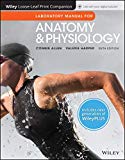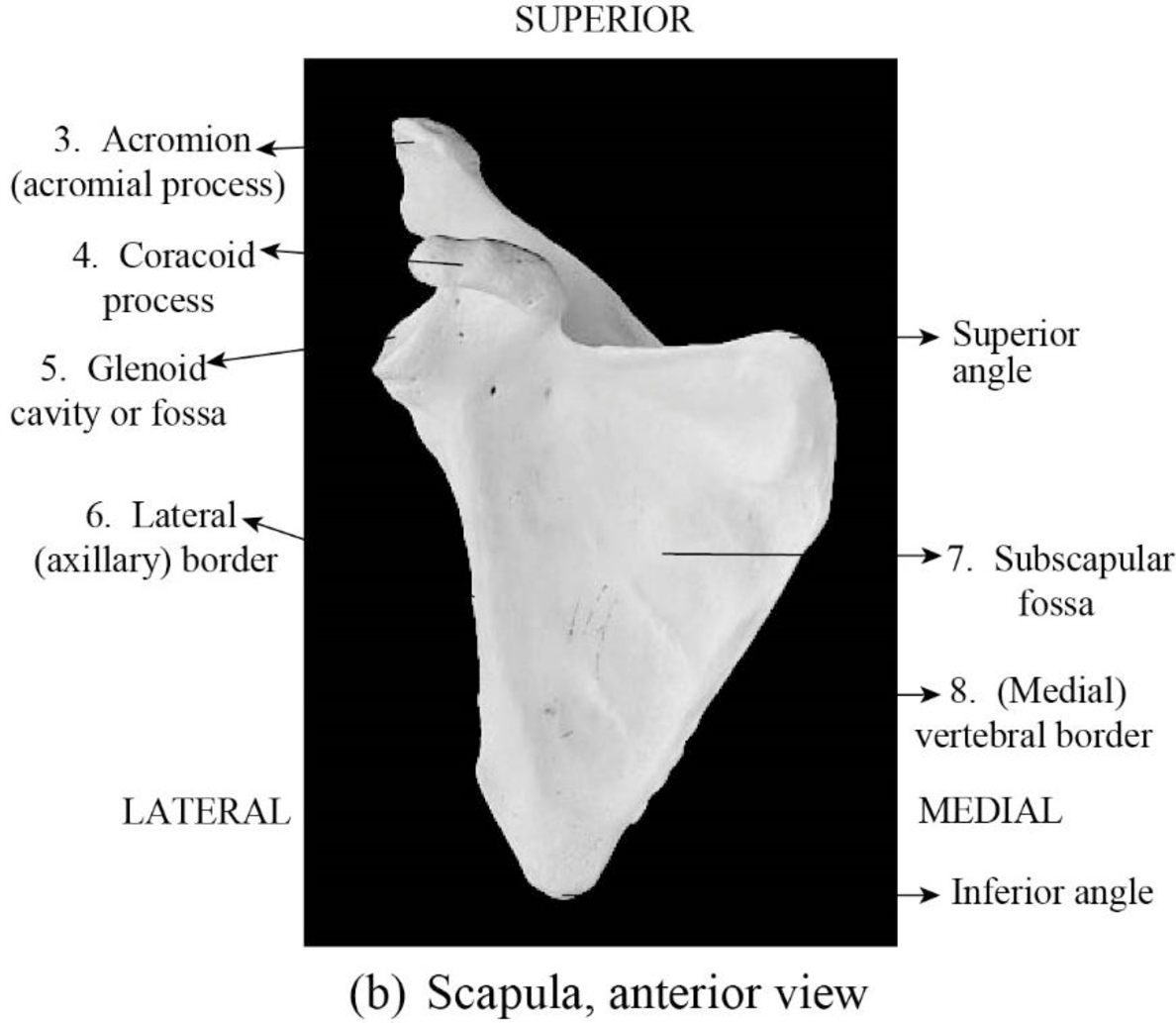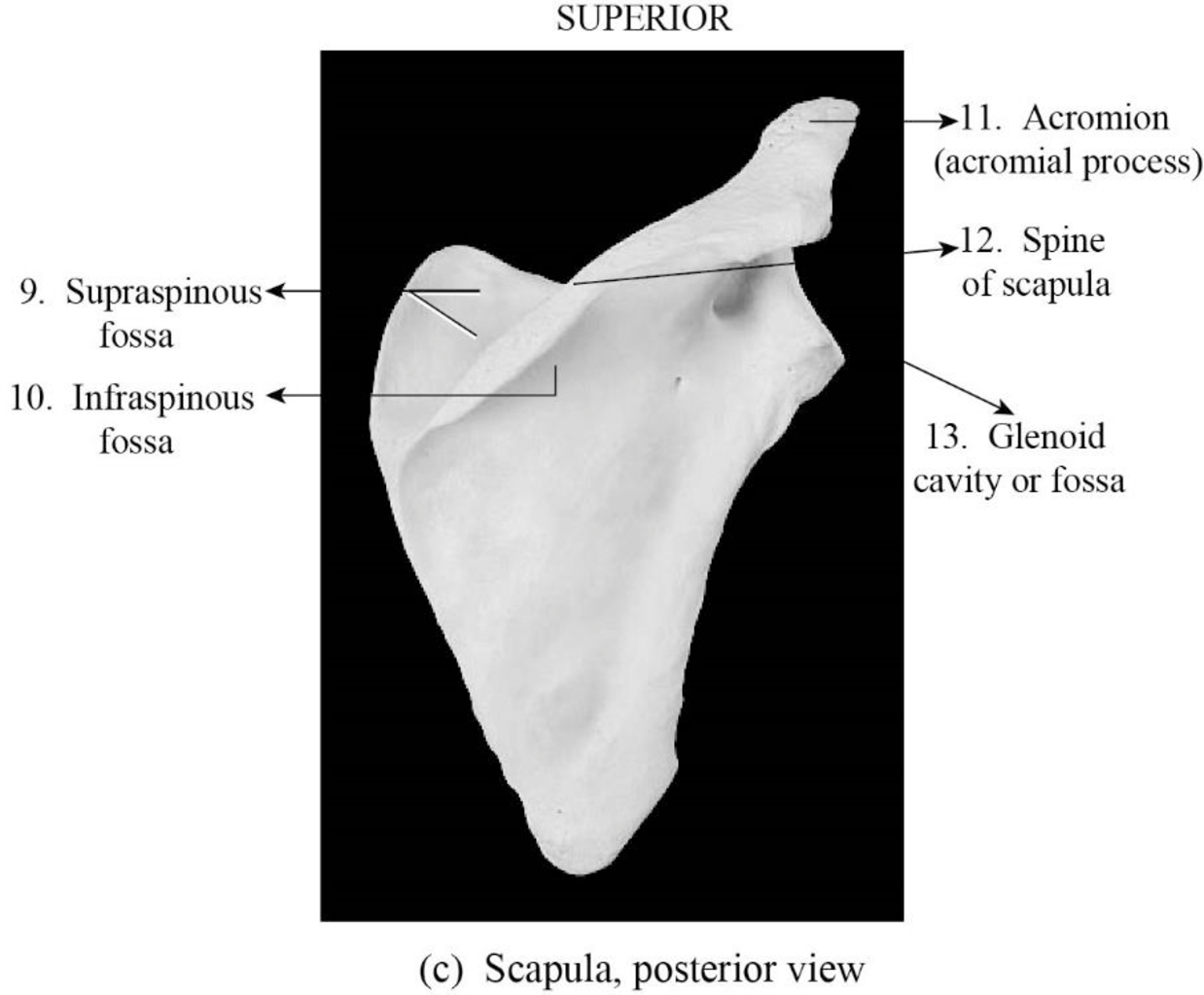
Concept explainers
To label: The parts of the clavicle in Figure 10.2 (a).
Introduction: Pectoral girdles are otherwise called shoulder girdle and they are the set of bones. An upper limb is attached to the axial skeleton by each pectoral girdle. Each shoulder girdle or pectoral girdle is composed of a clavicle and a scapula.
Answer to Problem 1.1BGL
Pictorial representation:

Fig1: The parts of the clavicle
Explanation of Solution
1. Acromial end: The acromial end is the flattened lateral end. It is anchored to the coracoid process by trapezoid ligaments and conoid. It articulates with the acromion.
2. Sternal end: The sternal end is the enlarged medial end. It articulates with manubrium sterni.
To label: The parts of scapula in Figure 10.2 (b).
Answer to Problem 1.1BGL
Pictorial representation:

Fig 2: The parts of the scapula anterior view
Explanation of Solution
3. Acromion (acromial process): Acromion is a portion of the scapula and it is found at the shoulder peak. The shape of the acromion is a triangle and it protrudes laterally. The acromion is otherwise referred as acromion process, which articulates with the collar bone or clavicle to form the acromioclavicular joint.
4. Coracoid process: The coracoid process is a thick, long curved projection attached by a broad base to the upper portion of the neck of the scapula.
5. Glenoid cavity or fossa: Glenoid cavity is a portion of the shoulder. It is depression inferior to acromion. The glenoid cavity is otherwise called a glenoid fossa of the scapula.
6. Lateral (axillary) border: The lateral border is a structural feature on the bone of scapula or border near the axilla. The lateral border of the scapula is also called an axillary border.
7. Subscapular fossa: Subscapular fossa is the concave depression on the anterior surface of the scapula. It provides origin to the subscapularis muscle. The subscapular fossa is otherwise called the shoulder bone.
8. (medial) vertebral border: The vertebral border is the edge or margin of scapula near the vertebral column. It extends to the inferior angle from a superior angle.
To label: The parts of the clavicle in Figure 10.2 (c).
Answer to Problem 1.1BGL
Pictorial representation:

Fig1: The parts of the scapula posterior view
Explanation of Solution
9. Supraspinous fossa: Supraspinous fossa is a depression superior to the spine. It provides origin to the supraspinatus muscle.
10. Infraspinous fossa: Infraspinous fossa is the depression or hollow on the dorsal aspect inferior to the spine. It mainly provides attachment to the infraspinatus muscle.
11. Acromion (acromial process): Acromion is the portion of the scapula and it is found at the shoulder peak. The acromion is otherwise referred as acromion process, which articulates with the collar bone or clavicle to form the acromioclavicular joint.
12. Spine of the scapula: The spine of the scapula is otherwise called a scapular spine. It is a sharp ridge present on the posterior side.
13. Glenoid cavity or fossa: Glenoid cavity is otherwise called a glenoid fossa of the scapula. The glenoid cavity is a portion of the shoulder. It is a depression inferior to acromion.
Want to see more full solutions like this?
Chapter 10 Solutions
Laboratory Manual for Anatomy and Physiology, 6e WileyPLUS (next generation) + Loose-leaf
- Identify the indicated tissue? (stem x.s.) parenchyma collenchyma sclerenchyma ○ xylem ○ phloem none of thesearrow_forwardWhere did this structure originate from? (Salix branch root) epidermis cortex endodermis pericycle vascular cylinderarrow_forwardIdentify the indicated tissue. (Tilia stem x.s.) parenchyma collenchyma sclerenchyma xylem phloem none of thesearrow_forward
- Identify the indicated structure. (Cucurbita stem l.s.) pit lenticel stomate tendril none of thesearrow_forwardIdentify the specific cell? (Zebrina leaf peel) vessel element sieve element companion cell tracheid guard cell subsidiary cell none of thesearrow_forwardWhat type of cells flank the opening on either side? (leaf x.s.) vessel elements sieve elements companion cells tracheids guard cells none of thesearrow_forward
- What specific cell is indicated. (Cucurbita stem I.s.) vessel element sieve element O companion cell tracheid guard cell none of thesearrow_forwardWhat specific cell is indicated? (Aristolochia stem x.s.) vessel element sieve element ○ companion cell O O O O O tracheid O guard cell none of thesearrow_forwardIdentify the tissue. parenchyma collenchyma sclerenchyma ○ xylem O phloem O none of thesearrow_forward
- Please answer q3arrow_forwardRespond to the following in a minimum of 175 words: How might CRISPR-Cas 9 be used in research or, eventually, therapeutically in patients? What are some potential ethical issues associated with using this technology? Do the advantages of using this technology outweigh the disadvantages (or vice versa)? Explain your position.arrow_forwardYou are studying the effect of directional selection on body height in three populations (graphs a, b, and c below). (a) What is the selection differential? Show your calculation. (2 pts) (b) Which population has the highest narrow sense heritability for height? Explain your answer. (2 pts) (c) If you examined the offspring in the next generation in each population, which population would have the highest mean height? Why? (2 pts) (a) Midoffspring height (average height of offspring) Short Short Short Short (c) Short (b) Short Tall Short Tall Short Short Tall Midparent height (average height of Mean of population = 65 inches Mean of breading parents = 70 inches Mean of population = 65 inches Mean of breading parents = 70 inches Mean of population = 65 inches Mean of breading parents = 70 inchesarrow_forward
 Human Anatomy & Physiology (11th Edition)BiologyISBN:9780134580999Author:Elaine N. Marieb, Katja N. HoehnPublisher:PEARSON
Human Anatomy & Physiology (11th Edition)BiologyISBN:9780134580999Author:Elaine N. Marieb, Katja N. HoehnPublisher:PEARSON Biology 2eBiologyISBN:9781947172517Author:Matthew Douglas, Jung Choi, Mary Ann ClarkPublisher:OpenStax
Biology 2eBiologyISBN:9781947172517Author:Matthew Douglas, Jung Choi, Mary Ann ClarkPublisher:OpenStax Anatomy & PhysiologyBiologyISBN:9781259398629Author:McKinley, Michael P., O'loughlin, Valerie Dean, Bidle, Theresa StouterPublisher:Mcgraw Hill Education,
Anatomy & PhysiologyBiologyISBN:9781259398629Author:McKinley, Michael P., O'loughlin, Valerie Dean, Bidle, Theresa StouterPublisher:Mcgraw Hill Education, Molecular Biology of the Cell (Sixth Edition)BiologyISBN:9780815344322Author:Bruce Alberts, Alexander D. Johnson, Julian Lewis, David Morgan, Martin Raff, Keith Roberts, Peter WalterPublisher:W. W. Norton & Company
Molecular Biology of the Cell (Sixth Edition)BiologyISBN:9780815344322Author:Bruce Alberts, Alexander D. Johnson, Julian Lewis, David Morgan, Martin Raff, Keith Roberts, Peter WalterPublisher:W. W. Norton & Company Laboratory Manual For Human Anatomy & PhysiologyBiologyISBN:9781260159363Author:Martin, Terry R., Prentice-craver, CynthiaPublisher:McGraw-Hill Publishing Co.
Laboratory Manual For Human Anatomy & PhysiologyBiologyISBN:9781260159363Author:Martin, Terry R., Prentice-craver, CynthiaPublisher:McGraw-Hill Publishing Co. Inquiry Into Life (16th Edition)BiologyISBN:9781260231700Author:Sylvia S. Mader, Michael WindelspechtPublisher:McGraw Hill Education
Inquiry Into Life (16th Edition)BiologyISBN:9781260231700Author:Sylvia S. Mader, Michael WindelspechtPublisher:McGraw Hill Education





